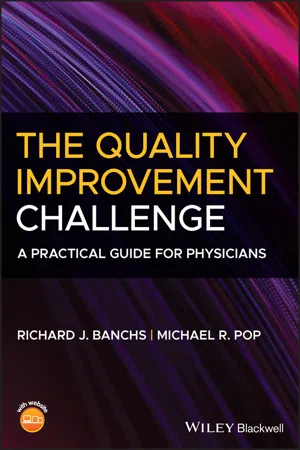
The Quality Improvement Challenge
A Practical Guide for Physicians
- English
- ePUB (mobile friendly)
- Available on iOS & Android
About This Book
Efforts to improve the quality of healthcare have failed to achieve a meaningful and sustainable improvement. Patients continue to experience fragmented, inconvenient, and unsafe care while providers are increasingly becoming overburdened with administrative tasks. The need for change is clear. Healthcare professionals need to take on new leadership roles in quality improvement (QI) projects to effect real change. The Quality Improvement Challenge in Healthcare equips readers with the skills and knowledge required to develop and implement successful operational improvement initiatives.
Designed for healthcare providers seeking to apply QI in practice, this valuable resource delivers step-by-step guidance on improvement methodology, team dynamics, and organizational change management in the context of real-world healthcare environments. The text integrates the principles and practices of Lean Six Sigma, human-centered design, and neurosciences to present a field-tested framework. Detailed yet accessible chapters cover topics including identifying and prioritizing the problem, developing improvement ideas, defining the scope of the project, organizing the QI team, implementing and sustaining the improvement, and much more. Clearly explaining each step of the improvement process, this practical guide:
- Presents the material in a logical sequence, gradually introducing each step of the process with clearly defined workflow templates
- Features a wealth of examples demonstrating QI application, and case studies emphasizing key concepts to highlight successful and unsuccessful improvement initiatives
- Includes end-of-chapter exercises and review questions for assessing and reinforcing comprehension
- Offers practical tips and advice on communicating effectively, leading a team meeting, conducting a tollgate review, and motivating people to change
Leading QI projects requires a specific set of skills not taught in medical school. The Quality Improvement Challenge in Healthcare bridges this gap for experienced and trainee healthcare providers, and serves as an important reference for residency program directors, physician educators, healthcare leaders, and health-related professional organizations.
Frequently asked questions
Information
PART I
THE BASICS
CHAPTER 1
The Problem with Healthcare
SO, WHAT’S THE PROBLEM?
HOW DID WE GET HERE?
- The business model. Healthcare organizations have been anchored in a business model that may have been successful in the past but has outlasted the circumstances that created the need for it. Despite the needs of the current marketplace, healthcare organizations have continued to focus on providing a full spectrum of healthcare services, that is, all services to all patients. Clayton Christensen in his book The Innovator’s Prescription (Christensen 2009) describes two types of business models that any organization can follow: a solution shop, where a healthcare organization focuses on diagnostic activities, and a value‐adding process where the focus is on the efficient delivery of care and specific treatments. Christensen argues that these two models are different, and they require different resources, processes, organizational structures, and profit models. With the current technological and scientific progress, healthcare challenges, and diversity of needs, trying to provide all services to all patients is the wrong value proposition. The combination of these two models under one roof creates a system that requires an enormous amount of resources, and results in inefficiencies, waste, and duplication of efforts. It creates a system that functions, as Michael Porter describes, as a “confederation of stand‐alone units that replicate services” (Porter 2016). For every dollar spent, a reported 30 cents are wasted in steps that do not add value, the result of excessive bureaucracy, defensive medicine, and duplication of services.
- Organizational structure. Healthcare organizations have customarily been organized according to clinical specialties. While this originally arose from the need to maintain the competency of clinicians to deliver high‐quality care, this structure has created clinical silos that have resulted in fragmented care and dysfuntional workflow across the healthcare organization. Rather than organizing care around specialty departments and special services, care should be organized around medical conditions with multiple subspecialties and teams converging on the specific patient condition. In the current system, effective synchronization, collaboration, and communication are often not present and are more often than not the cause of rework, mistakes, complications, and wasteful spending.
- The quality paradigm. In the traditional quality paradigm, quality was defined by the provider and by the effectiveness of care. In this view, quality is achieved when the right treatment is administered in response to a specific recognizable pattern, and results in the elimination of the disease condition. This long‐held view of quality ignored additional dimensions of quality care, such as the need for efficiency, timeliness, and patient‐centeredness (IOM 2001). Focusing only on effective care resulted in a healthcare experience that fell short of patients’ expectations. The traditional quality paradigm, a lack of oversight, and the inability of physicians to regulate their own profession has had a significant impact on the quality of care. As a result, we have seen unethical practices, high rates of patient injuries, and injustices in the ability to access care (Berwick 2016).
- The physician compensation model. Incentives for payment have been completely misaligned with the goals of improving the quality of care. Providers and healthcare organizations have been paid for number of procedures performed (volume‐driven pay...
Table of contents
- Cover
- Table of Contents
- Title Page
- Copyright Page
- Dedication Page
- Why This Book?
- About the Authors
- List of Stories, Examples, Exercises and Case Studies
- About the Companion Website
- PART I: THE BASICS
- PART II: THE FIRST “R”: THE RIGHT PROJECT
- PART III: THE SECOND “R”: THE RIGHT PEOPLE
- PART IV: THE THIRD “R”: THE RIGHT PROBLEM
- PART V: THE FOURTH “R”: THE RIGHT CAUSE
- PART VI: THE FIFTH “R”: THE RIGHT SOLUTION
- PART VII: ADDITIONAL THINGS YOU MAY NEED TO KNOW
- APPENDIX
- Index
- End User License Agreement